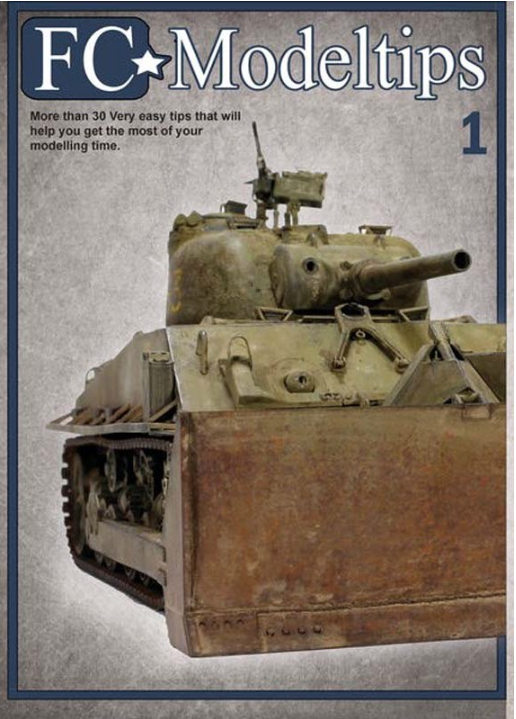 Loading... Please wait...
Loading... Please wait...Vallejo FC Model Tips Book Review
Posted by Glen Broman on 28th Mar 2016
Product Review
By Federico Colada
Reviewed by Glen Broman
Christopher Walken loves cowbells. Robert Duvall loves the smell of napalm in the morning. Gunnery Sergeant Hartmann loves his Marine Corps. Me, I love modelling technique books. I also love the smell of napalm in the morning, but that’s a story for another day. Perhaps I’m terminally lazy, but I feel it’s generally easier to steal someone else’s technology than to develop my own. Plus I really like all the cool model pictures. It’s a twofer, such a deal. When I was working with high explosives, I found that trial and error was not always the best learning paradigm. Perhaps that has rubbed off on my model building.
Awhile back I was dropping off some reference pictures to Dave Youngquist at the famous Last Cavalry World Headquarters when I got a serious case of shiny object syndrome. The new FC Modeltips book was in and I was hooked. Granted, many technique books have a distressing repetition, even though the pictures are cool. Then there are those that rise above, like the classic Shep Paine books, and pretty much anything by Bill Horan. Then there is another category, like FC Modeltips, that have useful tips I had never seen before. Like a refund from the IRS, that’s always a pleasant surprise. Even better, this is titled Volume 1. One can safely assume that this means there will be a Volume 2. To slightly digress, I always thought a great marketing strategy would be to develop a really excellent modelling book and title it “Volume 2”. After folks had spent some time going bonkers looking for the out of print “Volume 1”, I would print me up a batch of “ultra-rare out of print Volume 1’s” and sell them only on EBay. See, all those college marketing classes weren’t wasted, although perhaps, my ethics courses were.
Back to reality, this is a large paperback with good quality pictures with clear and informative captions. Although there are a few misspelled words and grammatical burps, the quality of the editing is generally better than many of the works coming from Spanish presses. Although the binding on this book is fine, I really feel that the best binding for technique books is spiral. Being able to lay out the book on your bench and refer to the techniques without having to wield a paintbrush in one hand and hold the book down with the other would be, in the immortal words of Martha Stewart, “a good thing”. Perhaps I will do this for my upcoming “Greatest modelling techniques of all time, Volume 2” project.
The book begins with a short introduction from the author title “Unstarted kits, delayed pleasures”. Wow that really resonates with me as a have a lifetime of delayed pleasures waiting for me in the basement. That sounds a bit twisted as it rolls off the lips, but you know what I mean. The first tip is outstanding, especially for those amongst us who have neither the patience for individual link tracks, nor the pocketbook for aftermarket ones. There are number of methods shown for making weld lines, a particularly useful tip for those who have purchased Dragon Sharman’s. You can also conserve some of your aftermarket budget by following the author’s suggestions for making glass and plastic bottles. There are number of chapters on diorama building tips, primarily covering building vacform building and texturing vacuform bases. There is also an interesting section on color theory, covering the distinctions between warm and cold colors and a demonstration of zenithal lighting. There are a number of good quality photos to demonstrate the techniques.
I found the section on six ways to paint tracks interesting. I don’t want to have to put in a spoiler alert and possibly ruin the surprise if you buy the book, so I won’t go into detail. Needless to say, one does not necessarily have to paint their tracks using just one of these methods, employing several is what I usually do. Following that is using printed wooden planks to replicate wood texture. The method described covers making your own wooden plank decals, but you could also use existing decal sets, Uschi Van Der Rosten’s come to mind. This is followed by methods of weathering plastic to look more “wood like”. Excellent stuff if you want your models to sport a little wood.
There are a number of techniques described which are well known and covered in most technique books, but the author uses his own terminology to name them. They are the same techniques used and demonstrated by Wilder, MIG and others, but with a different name. Nothing new, but the photos and descriptions would be useful to someone seeing them for the first time. One new tip is using felt tip pens to do stains. The book closes with a number of sections on different weathering techniques.
Overall I found this a useful book with some new and interesting techniques. This book is aimed at the wheelhouse of the beginning and intermediate armor modeler, but there are a few tips in here that would be new to more experienced modelers. I would also recommend this to modelers of all skill levels who are working to a budget. There are a number of tips in here that can produce good results without using expensive materials.
I purchased my copy from Last Cavalry

